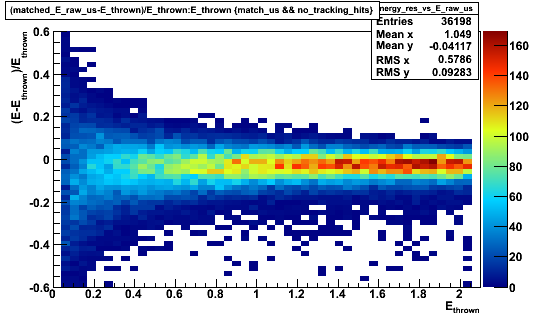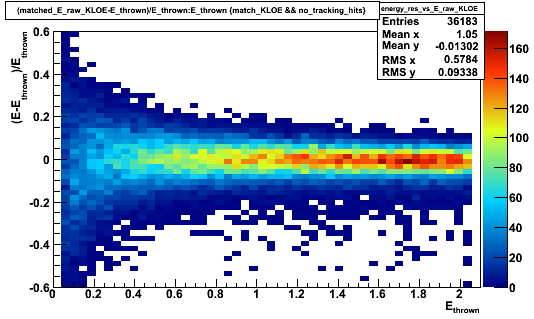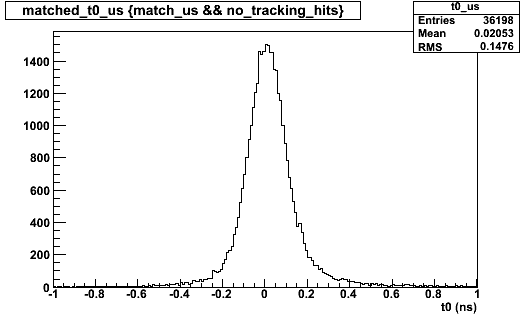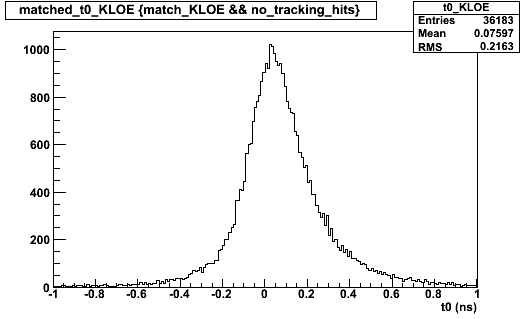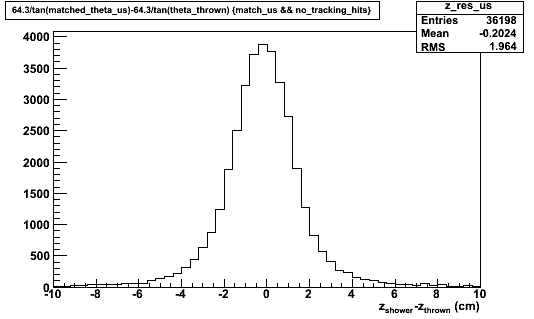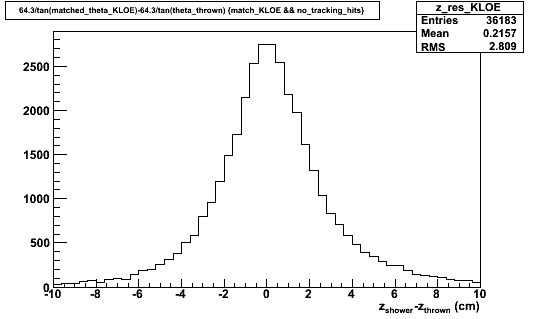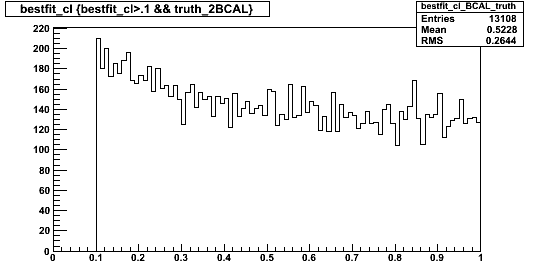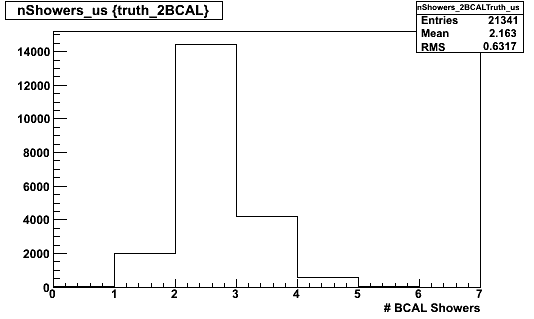BCAL reconstruction 11/28/11
Contents
Summary
- Two algorithms for BCAL reconstruction in sim-recon: KLOE algorithm (default), new algorithm (GlueX) by Matt S.
- 1234 segmentation now an option in reconstruction code (for both algorithms)
- 1234 now default, used for all plots on this page
- New algorithm comparable to or better than KLOE algorithm in most tests I tried
- Single photon events: (much) better timing resolution, better angular resolution, same energy resolution, but more extraneous clusters
- Single pi0 events: ~5% more pi0's reconstructed, better energy resolution
- b1pi events: slightly more pi0's reconstructed, better energy resolution, slightly fewer extraneous clusters
Changes
- Checked in:
- More flexible DBCALGeometry allows 1234 summing
- Change weighting when averaging quantities to form cluster
- Improve error estimation
- Tune parameters
- Fix various bugs
- Change in KLOE algorithm to min energy threshold of cluster to make the two algorithms match
- Not yet checked in
- More changes to the way errors are calculated
- Changes to clusterization
Single photon event sample
- 45000 events
- energy uniformly distributed from .05-2.05 GeV
- angles from 10.8-118
- to exclude events with photon conversion, etc., only look at events with a "primary" DBCALTruthShower (81% of events)
- all results with 1234 summing.
Efficiency
efficiency of reconstructing at least one shower with abs(phi-phi_thrown)<.06 rad: >99.5% for both algorithms.
Energy resolution
- looking at "raw" energies of shower
energy resolution vs. thrown photon E
KLOE collects more BCAL hits in a shower->less negative mean
Timing resolution
For KLOE algorithm, shower time t is just weighted average of hit times (?).
For GlueX algorithm, t is time to inner radius.
Look at t0=t-t_travel, where t_travel is the time it takes for a photon to travel from center of target to shower position (x,y,z) (for KLOE algorithm) or to inner radius (GlueX algorithm)
GlueX:
KLOE:
new algorithm has much better timing resolutions
- Mostly due to weighting average of hit times by E^2 (hit energy squared) rather than E
- Averaging times at inner radius rather than at hit position doesn't make much difference
distributions above not centered at 0
- not really sure why
Angular resolution
How well can we reconstruct shower theta (or equivalently z)?
GlueX:
KLOE:
GlueX algorithm has better resolution
Number of showers reconstructed
Average # of showers reconstructed:
- GlueX: 1.39
- KLOE: 1.05
New algorithm has more extraneous showers in the single photon sample. I think this is because this algorithm doesn't merge clusters that are close in phi but separated in theta. This is something that should be still be worked on, but doesn't seem urgent since this algorithm has fewer extraneous clusters in the more complicated event samples.
Single pi0 event sample
~64000 pi0's isolated from a bggen sample using extract_ptype_hddm plugin.
Again we can use DBCALTruthShower info to include only events where the two decay photons make it to the BCAL. 33% of events meet these criteria. This excludes events with photon conversion and also excludes events where one or both of the photons end up the FCAL.
Hard to get an exact count of how many pi0's are reconstructed/reconstructable, so I tried two different methods.
Method 1
Use DTwoGammaFit to fit all pairs of two photons to pi0 mass.
To get the correct errors, all particles are generated from the center of the target and the error on the vertex is set to 0.
Problems with this method:
- it relies on having correct errors, which we don't quite have yet.
- extraneous showers could produce spurious pi0 fits
Just count the number of events where there is a pi0 fit with confidence level > 10%.
- GlueX algorithm: 73% efficiency
- KLOE algorithm: 61% efficiency
GlueX algorithm has better pi0 energy resolution and angular resolution.
GlueX:
KlOE:
The downward slope in the KLOE confidence level plot indicates that the errors are wrong and too few events will be accepted by the c.l. cut...
Method 2
Look at the two most energetic photons in an event. If the combined four-momentum falls "close" to the thrown pi0 four-momentum, count this a "good" reconstructed pi0.
Problems
- different definitions of "close" lead to different results
efficiency:
- GlueX: 79% efficiency
- KLOE: 71% efficiency
GLuex has better angular, energy resolution
Number of showers
For this subset of events, we should see exactly 2 BCAL Showers
GlueX:
KLOE:
It's not really clear to me which algorithm is doing a better job...
b1pi event sample
10000 b1pi events from genr8
Momentum of reconstructed photon depends on vertex, which is determined by tracking code. To avoid this complication, cheat and use the truth vertex when reconstructing photons.
Can count the number of reconstructed BCAL photons "close" to thrown photons.
- GlueX: 9486 "good" reconsructed BCAL photons/12030 thrown BCAL photons=79%
- KLOE: 9104/12030=76%
Avg. Number of BCAL showers:
- GlueX: 5.8
- KLOE: 6.0
Good matching pi0 (# of events that have a pi0 fit with prob>1% and "close" to the thrown pi0. Includes FCAL photons):
- GlueX: 5695
- KLOE: 5469
Try using DBCALTruthShower info:
Since the pi0's decay to photons prior to hdgeant, the two decay photons correspond to "primary" DBCALTruthShower's. The DBCALTruthShower corresponding to decay photons can be identified by their track.
Number of reconstructed DBCALShower's "close" (in E,z,phi) to a decay-photon-DBCALTruthShower:
- GlueX: 6994/8101=86%
- KLOE: 6693/8101=83%
For events with two "primary" DBCALTruthShower's from the pi0, # of events with a good reconstructed pi0 "close" to thrown pi0:
- GlueX: 1195/1777=67%
- KLOE: 1081/1777=61%
Things
- Further work on errors...
- Cluster overlap function tweaks -> better energy resolution
- Theta res distributions off-center
- Very forward particles energy calibration, general energy calibration scheme
- Extra showers at ~12 deg, low energy
- What is cluster rho good for?
- Adding hits as associated objects...
- FCAL issues?
Cuts5
(need fancier way to determine resolutions?)
single photon
- (corrected) energy res better: .08724 vs. 09197
- time res worse: 0.1605
- z res worse: 2.059
- nshowers better: 1.17
pi0
- method 1: slightly worse 15387
- method 2: slightly worse 78%
(could easily be due to nShowers distribution looks better, more 2 shower events, less 1shower events, less 3+shower events than both KLOE and GlueX
b1pi
- good photons: 8949
- avg BCAL showers: 4.73
- good matching pi0: 5451
- E_res BCAL: .1748
pi0 resolutions 2truth showers info
